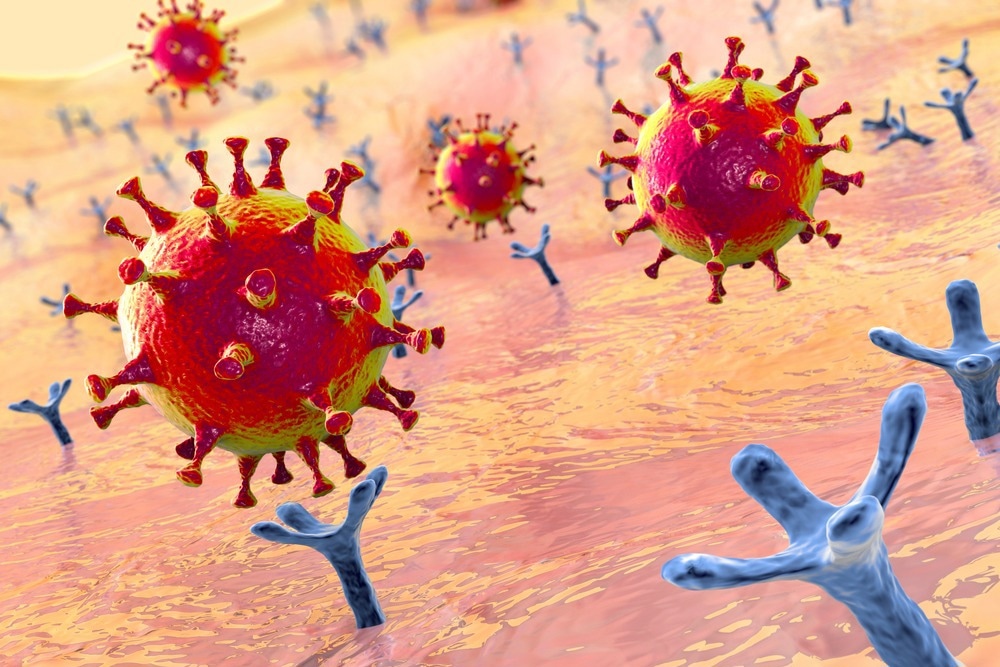In a recent study posted to the bioRxiv* server, researchers investigated the reasons for the rapid advent of severe acute respiratory syndrome coronavirus 2 (SARS-CoV-2) XBB.1.5, a sublineage of the Omicron recombinant mutant XBB in the United States of America (USA).
 Study: Enhanced transmissibility of XBB.1.5 is contributed by both strong ACE2 binding and antibody evasion. Image Credit: Kateryna Kon/Shutterstock
Study: Enhanced transmissibility of XBB.1.5 is contributed by both strong ACE2 binding and antibody evasion. Image Credit: Kateryna Kon/Shutterstock

 This news article was a review of a preliminary scientific report that had not undergone peer-review at the time of publication. Since its initial publication, the scientific report has now been peer reviewed and accepted for publication in a Scientific Journal. Links to the preliminary and peer-reviewed reports are available in the Sources section at the bottom of this article. View Sources
This news article was a review of a preliminary scientific report that had not undergone peer-review at the time of publication. Since its initial publication, the scientific report has now been peer reviewed and accepted for publication in a Scientific Journal. Links to the preliminary and peer-reviewed reports are available in the Sources section at the bottom of this article. View Sources
Background
XBB.1.5 might drive the next global wave of coronavirus disease 2019 (COVID-19) due to its growth advantages over BQ.1.1 and XBB.1 strains. The researchers believe that a Serine486Proline mutation in the spike (S) protein of XBB.1.5 is driving its rapid transmission. This rare, two-nucleotide substitution is absent in Omicron subvariant XBB.1 and thus needs to be immediately investigated.
About the study
In the present study, researchers collected blood plasma samples from individuals recovering from a breakthrough infection (BTI) by Omicron subvariants, BF.7, BA.1, and BA.5 completed a three-dose regimen of CoronaVac.
Another study cohort had individuals recovering from BA.5 BTI and vaccinated with primary vaccination series of messenger ribonucleic acid (mRNA)-1273 or BNT162b2 vaccines. The team collected plasma samples associated with CoronaVac and the mRNA vaccines on average four and within two to three weeks after hospital discharge, respectively.
They used pseudovirus neutralization (PVN) assays to estimate plasma neutralization titers against XBB.1.5 compared to B.1 (D614G) variant. In addition, the researchers assessed human angiotensin-converting enzyme 2 (hACE2)-binding affinity of the receptor-binding domain (RBD) of XBB.1.5 using surface plasmon resonance (SPR) assays. They compared the SPR results of XBB.1.5 with that of XBB.1, BA.2.75, and BQ.1.1.
Study findings
Compared to XBB.1.5 and B.1, plasma from BA.5 BTI patients vaccinated with CoronaVac showed a 39- and 44-fold decrease in 50% neutralization titer (NT50), respectively. Likewise, in BF.7 BTI patients vaccinated with CoronaVac, the plasma NT50 against XBB.1.5 decreased 27-fold relative to that against B.1. Plasma from mRNA-vaccinated individuals recovering from BA.5/BA.1 BTI showed a similar pattern of decline, indicating that albeit slightly weaker, XBB.1.5 showed a comparable humoral immune escape ability as XBB.1, its parent mutant. Moreover, XBB.1.5 similarly evaded therapeutic monoclonal antibodies as XBB.1, except SA55. Also, S309 showed weaker but some neutralization activity against XBB.1.5.
Strikingly, the RBD of XBB.1.5 had a much stronger hACE2-binding affinity than XBB.1 but was comparable to BA.2.75, with dissociation constants (KD) of 3.4 nM vs. 19 nM vs. 1.8 nM. Perhaps this is why XBB.1.5 had a substantial growth advantage over XBB.1 while displaying an exceptionally high immunity-evading potential. Furthermore, the study results explain why XBB mutant and XBB.1 prevailed in only some countries, e.g., India, but BQ.1.1 quickly disseminated across the globe.
Conclusions
Given its high hACE2-binding affinity, XBB.1.5 might acquire more immune-evasion mutations, like BA.2.75, under selective pressure. Also, it might have different pathogenicity compared to the parental mutant strain, XBB. The mechanisms governing the increased pathogenicity and transmissibility of XBB.1.5 requires urgent in-depth investigations. Most importantly, the authors advocated for close monitoring of the circulation and evolution of XBB.1.5 to help develop effective therapeutic antibodies and vaccines against it.
Declaration of Competing Interest
Y.C. is a co-founder of Singlomics Biopharmaceuticals and inventor of provisional patents associated with SARS-CoV-2 neutralizing antibodies, including SA55 and SA58.

 This news article was a review of a preliminary scientific report that had not undergone peer-review at the time of publication. Since its initial publication, the scientific report has now been peer reviewed and accepted for publication in a Scientific Journal. Links to the preliminary and peer-reviewed reports are available in the Sources section at the bottom of this article. View Sources
This news article was a review of a preliminary scientific report that had not undergone peer-review at the time of publication. Since its initial publication, the scientific report has now been peer reviewed and accepted for publication in a Scientific Journal. Links to the preliminary and peer-reviewed reports are available in the Sources section at the bottom of this article. View Sources
Journal references:
- Preliminary scientific report.
Yue, C. et al. (2023) "Enhanced transmissibility of XBB.1.5 is contributed by both strong ACE2 binding and antibody evasion". bioRxiv. doi: 10.1101/2023.01.03.522427. https://www.biorxiv.org/content/10.1101/2023.01.03.522427v1
- Peer reviewed and published scientific report.
Yue, Can, Weiliang Song, Lei Wang, Fanchong Jian, Xiaosu Chen, Fei Gao, Zhongyang Shen, Youchun Wang, Xiangxi Wang, and Yunlong Cao. 2023. “ACE2 Binding and Antibody Evasion in Enhanced Transmissibility of XBB.1.5.” The Lancet Infectious Diseases, February. https://doi.org/10.1016/s1473-3099(23)00010-5. https://www.thelancet.com/journals/laninf/article/PIIS1473-3099(23)00010-5/fulltext.